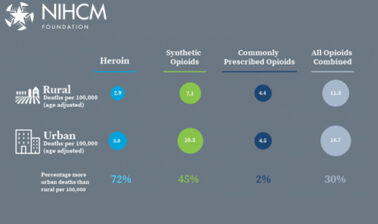Infographics
Sources and Burden of Opioid Deaths
Published on: May 20, 2019. Updated on: April 05, 2021.

About the Data Insights
This infographic depicts how the opioid crisis has intensified and evolved despite public and private sector efforts to prevent addiction and increase access to treatment. Overdose deaths from heroin and synthetic opioids like fentanyl increased markedly and hit young adults and men particularly hard. Though some think of the opioid crisis as affecting mainly rural America, per capita death rates from opioids were much higher in urban areas.
Notes on Data and Methods
All data on opioid overdose deaths were derived from the multiple cause-of-death files of the Wide-ranging Online Data for Epidemiologic Research (WONDER) data system maintained by the Centers for Disease Control and Prevention (CDC). The information was last updated in December 2018 to reflect data through 2017.
Deaths were identified as due to an opioid overdose if the ICD-10 code for the underlying cause of death was X40-X44 (accidental poisoning), X60-X64 (intentional self-poisoning) or Y10-14 (poisoning of undetermined intent) and if any of the multiple cause of death codes indicated that the type of substance involved in the poisoning was T40.1 (heroin), T40.2 (natural and semi-synthetic opioids), T40.3 (methadone) or T40.4 (synthetic opioids other than methadone). Because a single death may involve multiple substances, summing across the number of deaths involving each substance will overestimate the number of opioid-related overdoses.
Following the classification scheme adopted by the CDC, methadone and natural and semi-synthetic opioids (e.g., oxycodone and hydrocodone) were grouped into a single category encompassing commonly prescribed opioids. Synthetic opioids other than methadone include substances such as tramadol and fentanyl (both pharmaceutically manufactured and illicitly manufactured).
In 2017, there were 46,298 overdose deaths involving one or more of the opioids described above, or one death every 11.4 minutes.
Of these deaths in 2017, 15,456 involved heroin, 28,402 involved synthetic opioids other than methadone, and 17,003 involved commonly prescribed opioids (some deaths were classified into more than one category). Comparable figures for the years 2002, 2007 and 2012 were, respectively:
- for heroin – 2,088; 2,393; and 5,904
- for synthetic opioids – 1,293; 2,209; and 2,623
- for commonly prescribed opioids – 6,468; 12,777; and 14,223
In 2017, 4,882 (31.6 percent) of all overdose deaths involving heroin and 8,805 (31.0 percent) of all overdose deaths involving synthetic opioids occurred among individuals aged from 25 to 34, whereas 4,234 (24.9 percent) of all overdose deaths involving commonly prescribed opioids occurred for individuals aged 45 to 54.
In 2017, 31,519 (68.1 percent) of the 46,298 opioid-related deaths occurred among men.
Compared to the 51-to-49 percent male-female split for deaths from all causes, men were significantly more likely than women to die from opioids, regardless of the substance involved. The starkest differences, however, were seen for deaths involving heroin and/or synthetic opioids. Of the 15,456 deaths involving heroin, 11,578 (74.9 percent) occurred among men. Similarly, of the 28,402 deaths involving synthetic opioids, 20,482 (72.1 percent) occurred among men. For commonly prescribed opioids, males accounted for 9,858 of the 17,003 deaths (58.0 percent).
The urban/rural breakdown of opioid deaths relied on the National Center for Health Statistics’ 2013 system for classifying counties as urban or rural according to whether the county was in a metropolitan statistical area (MSA) or not. Deaths were assigned to location based on the county of the person’s legal residence.
In 2017, there were 41,168 opioid overdose deaths among residents of urban areas, relative to the total urban population of 279.6 million, yielding a death rate of 14.72 deaths per 100,000 people. Comparable figures in rural areas were 5,130 overdose deaths relative to a population of 46.1 million, for a rate of 11.13 deaths per 100,000. Thus, the average urban resident was 32 percent more likely than the average rural resident to perish from an opioid overdose.
Comparable figures by type of opioid were:
- Heroin – 14,274 urban deaths and 1,182 rural deaths, translating to death rates of 5.10 deaths per 100,000 urban residents and 2.56 deaths per 100,000 rural residents, or a 99 percent higher likelihood of dying from a heroin-involved overdose among urban residents.
- Synthetic Opioids – 25,611 urban deaths (9.16 per 100,000 urban residents) vs. 2,791 rural deaths (6.06 per 100,000 rural residents) for a 51 percent higher rate in urban areas.
- Commonly Prescribed Opioids – 14,630 urban deaths (5.23 per 100,000 urban residents) vs. 2,373 rural deaths (5.15 per 100,000 rural residents), or a 2 percent higher rate in urban counties.
More Related Content
See More on: Prescription Drugs | Social Determinants of Health | Substance Use

